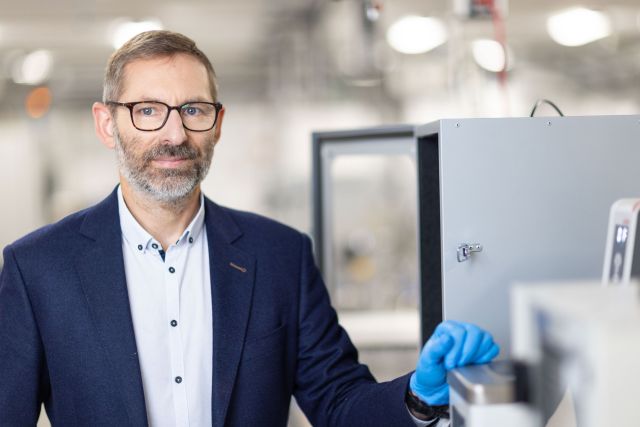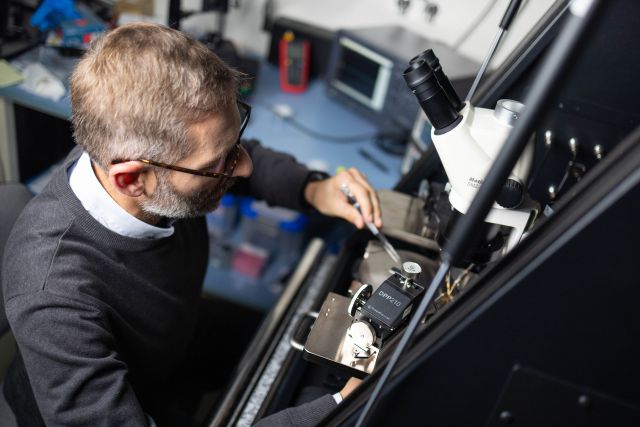Principal Investigator
:
Dr hab. inż. Robert Bogdanowicz
Gdańsk University of Technology
Panel: ST7
Funding scheme
: OPUS 22
announced on
15 September 2021
Our project represents an important innovation in the field of carbon nanomaterials. Nanostructures are geometric, complex, often periodic surfaces of nanometric size, i.e., approximately 1/100 thinner than a human hair. Our project focuses on developing periodic diamond nanostructures with extraordinary optical and electronic properties, which are difficult or impossible to achieve using conventional technologies. Importantly, we use synthetic diamond for that purpose, which means we can obtain materials characterised by exceptional chemical stability and biocompatibility.
Diamond is well known for its incredible hardness, which means it is very difficult to nanostructurise, i.e., have its surface shaped in nanoscale with the use of atoms. However, thanks to advanced technologies used in the semiconductor industry, we are able to deposit synthetic diamond in form-defined matrices to create three-dimensional nanostructures. Another approach is to fabricate three‐dimensional nanostructures from diamond composites that induce periodicity.
 dr hab. inż. Robert Bogdanowicz, fot. Michał Łepecki
The aim of our project is to develop and study new three-dimensional diamond nanostructures, optimised for applications in medicine and biosensor production. What makes our structures unique is the possibility of obtaining simultaneous optical and electrochemical signals, which reduces the risk of error and shortens measurement time as compared to traditional sensors. Taken together, optical and electrochemical data are very reliable and useful for early diagnostics. This advance allows us to detect specific biological targets, such as viruses, cancer cells, bacteria and disease markers in a highly selective and sensitive manner. Biosensors are detection platforms that use biological receptors, such as antibodies, to detect different biological targets. In order to achieve adequate selectivity for a given biological target, the sensors need to be bio‐functionalised; their surface must be sensitised to specific biological interactions with specific proteins, which are antigen proteins in our case.
dr hab. inż. Robert Bogdanowicz, fot. Michał Łepecki
The aim of our project is to develop and study new three-dimensional diamond nanostructures, optimised for applications in medicine and biosensor production. What makes our structures unique is the possibility of obtaining simultaneous optical and electrochemical signals, which reduces the risk of error and shortens measurement time as compared to traditional sensors. Taken together, optical and electrochemical data are very reliable and useful for early diagnostics. This advance allows us to detect specific biological targets, such as viruses, cancer cells, bacteria and disease markers in a highly selective and sensitive manner. Biosensors are detection platforms that use biological receptors, such as antibodies, to detect different biological targets. In order to achieve adequate selectivity for a given biological target, the sensors need to be bio‐functionalised; their surface must be sensitised to specific biological interactions with specific proteins, which are antigen proteins in our case.
The project crucially involves international cooperation between Polish and Czech researchers. Researchers based in Prague specialise in developing and diagnosing periodic diamond structures; researchers in Gdańsk focus on modifying their electrochemical parameters; and our Warsaw team has expertise in optoelectronics, mainly dealing with biosensors. This synergy of expertise and experience will help us understand and develop the potential of these fascinating nanostructures.
Project title: Heterogenous diamond biosensing nanoarchitectures: opto-electro-chemical interactions with antibody complexes
Dr hab. inż. Robert Bogdanowicz
Bogdanowicz earned a PhD in electronics (summa cum laude) from the Gdańsk University of Technology in 2009, and went on to devote the next few years of his career to researching and developing innovative technologies. In 2010-2011, he worked as a post-doc in Germany and, upon his return to Poland, took leadership of a research team at the Department of Metrology and Optoelectronics of the Gdańsk University of Technology. His research focuses on the development of CVD (Chemical Vapor Deposition) diamonds and their applications in biomedical, environmental and biochemical sensors. In 2015, he was a Fulbright Senior Scholar Award Program fellow at the California Institute of Technology (Caltech), where he joined a team led by Professor William Goddard (Materials and Process Simulation Center), working on hybrid 3D diamond structures. He is the author of more than 200 articles, book chapters, conference materials and special issues of scientific journals such as “Diamond and Related Materials”, as well as the owner of 8 patents. His innovative diamond-based sensor technology is already being developed by industry.


